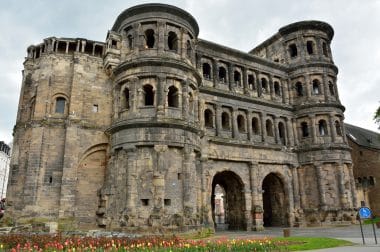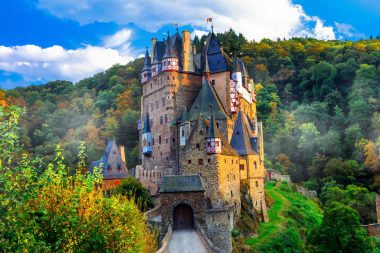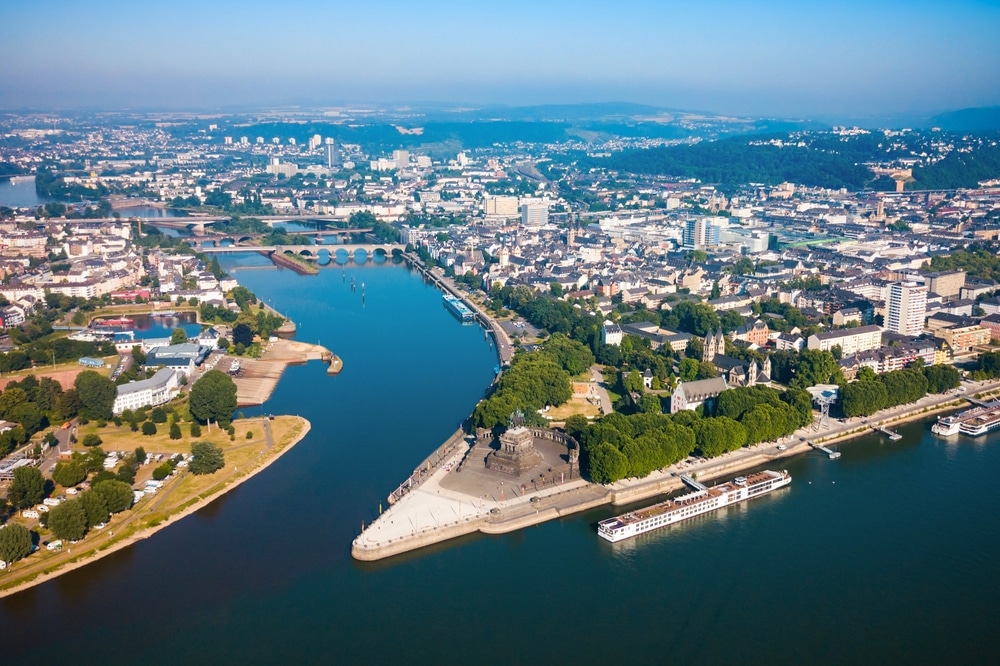The region around the Moselle Valley and the Middle Rhine region along the course of the Moselle River is probably one of the most beautiful natural areas in Germany. The Moselsteig Trail, which winds its way from the German-Luxembourg border near Trier to the Deutsches Eck in Koblenz, is one of the most picturesque long-distance hiking trails in our country. With a total of 24 stages on well-developed hiking trails, the Moselsteig Trail invites not only hikers who want to hike the entire trail, but also those who are only planning day trips or want to experience part of it. Through vineyards, along castles, palaces and ruins, the Moselsteig Trail offers some wonderful excursion destinations. In the following article, we will introduce you to some of the most beautiful highlights along the Moselsteig Trail.
The Porta Nigra in Trier

The Porta Nigra (Latin for “Black Gate”), built in the 2nd century AD, is the landmark of the city of Trier and known far beyond the borders of the region. It has been a UNESCO World Heritage Site since 1986. The Porta Nigra was built at the time of the Roman Emperor Marcus Aurelius. It is still unclear today whether the gate served as the city gate of the then settlement Augusta Treverorum, from which Trier later emerged, or whether it was only intended as a representative building from the beginning. Over the centuries, the Porta Nigra has been rebuilt several times. Above all, the expansion into a church in the Middle Ages should be mentioned in this regard. It was not until the reign of Napoleon that the additions were removed again and the original Roman gate exposed. This is one of the reasons why the gate has been preserved in exceptionally good condition to this day and testifies to the eventful history of Trier and the region.
Neumagen Wine Ship
The Moselle Valley is considered one of the most traditional wine-growing regions in Germany and Europe. The so-called Neumagen wine ship is one of the oldest evidence of this long tradition. It is the part of a tomb representing a wine transport ship, which probably served as a memory of a winegrower or winegrower. The wine ship, which dates back to 270 AD, was found in the village of Neumagen at the end of the 19th century. This is the destination of the eighth stage of the Moselsteig Trail (from Leiwen to Neumagen-Dhron). The original wine ship can now be viewed in the State Museum in Trier, and a reconstruction is on display in Neumagen. A special highlight is also the seaworthy replica of the wine ship based on the model of the ship from the tomb, which is anchored at Neumagen-Dhron and can be chartered by tour groups.
Mont Royal Fortress
About halfway along the Moselsteig Trail near Traben-Trarbach is the Mont Royal fortress ruins. Mont Royal was a fortress built in the 17th century during the reign of Louis XIV. It served as an important supply base for the French armed forces, which occupied the region at the time. On an area of a total of 50 hectares, almost 10,000 people found space. After the end of the French occupation, the fortress was abandoned and gradually fell into disrepair. It was not until the 20th century that the ruins were uncovered. For tourist visitors, the picturesque, enchanted remains of the fortress construction are still an attractive destination today.
Reichsburg Cochem
The situation is completely different at the Reichsburg Cochem. The hilltop castle, originally built in the 12th century, served as a so-called customs castle in the Middle Ages, from which the collection of customs duties for navigating the Moselle was organized. The castle was largely destroyed until the 17th century, and it was not until the late 19th century that it was restored or rebuilt. The Reichsburg Cochem is located on the 19th stage of the Moselsteig Trail and can be seen from afar due to its prominent location on a mountain cone at the gates of the city of Cochem. It is surrounded by vineyards and offers a picturesque panorama.
Eltz Castle

A very special highlight on the Moselsteig Trail is Eltz Castle near Wierschem, also built in the 12th century, on the 21st stage of the Moselsteig Trail. It is considered by many to be the most beautiful castle in Europe. Unlike Cochem Castle, for example, Eltz Castle was never destroyed and was only restored and expanded on a smaller or larger scale over the centuries. The castle, which has been owned by various lines of the Eltz family for more than 800 years, can be visited for an entrance fee. Its unique location directly on a steep slope ensured that the castle could never be conquered by attackers over the centuries. The ruins of the Trutzeltz siege castle on a nearby hill still bear witness to the futile siege attempts.
Deutsches Eck
The Deutsches Eck in Koblenz is not only the destination of the Moselsteig Trail, but also the end point of the Moselle, which flows into the Rhine here. The Deutsches Eck itself is an artificially raised headland from which the mouth of the Moselle can be visited in all its glory. The monumental Kaiser Wilhelm statue on the headland is also an impressive sight. The Deutsches Eck received a special upgrade with the 2011 Federal Garden Show, parts of which were held on the headland. On this occasion, the Rhine cable car was also created, which runs from the Deutsches Eck over the Rhine to Ehrenbreitstein Fortress. The ride on the cable car is a special experience and provides a unique view of the Moselle estuary


